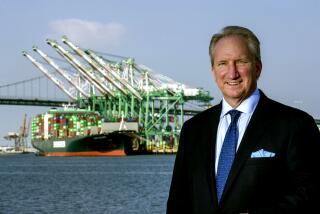Tuna Cannery Is Last Survivor of a Bygone Era : Commerce: The tuna canning industry was born and thrived on Terminal Island. Today, just one company remains.
- Share via
Steve Edney was there 40 years ago when America’s tuna canning industry came of age on Terminal Island. And in its own way, he says, the gritty industrial heart of Los Angeles Harbor was every bit as important as New York’s Ellis Island to the immigrants who found work in the canneries.
Every day for decades, he remembers, thousands of cannery workers would come to work on the ferries from San Pedro or by car across the Henry Ford Bridge. When they arrived at Fish Harbor, for work that was hard but steady, to jobs that paid them enough to feel a part of the American Dream, they would march to the canneries wearing spotless white uniforms and caps as if they were in a parade.
“It was really something to see,” Edney says.
But today, as America’s economic might seems increasingly in doubt, the place where the nation’s tuna canning industry began at the turn of the century is also where Edney and others fear it could die.
Over the last decade, a devastating combination of foreign competition, U.S. trade policies and other factors have pummeled the industry, idling huge canneries and displacing untold thousands of factory workers, fishermen and others whose livelihood once seemed assured.
At its peak, the industry was bustling with competition from 18 canneries that provided some 17,000 jobs on Terminal Island--birthplace of America’s fish canning industry--and San Diego, home to its tuna fleet.
Today, only one tuna processing cannery--Pan Pacific Fisheries Inc. on Terminal Island--remains open in the continental United States. And Edney and others worry that it is only a matter of time before Pan Pacific and its 640 workers succumb to the same economic pressures that have claimed other mainland canneries.
“We need help. And no one seems to be listening,” says Edney, national director for the United Industrial Workers, which represents an array of government and private workers under the umbrella of the Maryland-based Seafarer’s International Union.
Though the tuna canneries’ decline during the 1980s parallels those of other U.S. industries that once dominated the world, Pan Pacific president Kevin Dolan says the plight of his industry has barely drawn notice from America’s consumers, business leaders and politicians.
“If we represented hundreds of thousands of jobs like the airline or automobile industries, our situation would be front-page news every day,” he said.
Instead, despite years of petitioning the White House, Congress and America’s bipartisan International Trade Commission, the tuna industry and the unions representing its workers have been unable to draw attention to their plight, according to Dolan and others.
“What we are fighting for here is survival of an American culture,” says Charles F. Woodhouse, president of MariFarms Inc., a New Jersey-based seafood company that owns Pan Pacific Fisheries.
That culture, though battered, remains at Pan Pacific, where cannery workers begin arriving before dawn each morning just as thousands have in the years since Pan Pacific opened in 1946.
Fanning out over the 10-acre cannery, where the odor of cooked fish never seems to fade, workers take the catch from tuna boats to one-ton cast-iron containers for freezing. Later, the tuna are thawed, butchered and cooked, and they are moved to Pan Pacific’s cavernous packing room.
There, inside a warehouse the size of a football field, rows of women in white uniforms stand for hours at long tables, using paring knives to clean and cut thousands of pounds of tuna each day. Standing almost shoulder-to-shoulder, they quarter the fish for placement on a conveyor that takes the tuna for canning.
From there, the cans are cooked for sterilization and then labeled, under 250 different names, for stores ranging from supermarkets such as Vons to gourmet stores such as Mrs. Gooch’s.
Although the industry’s decline has its historical roots in a World War II trade agreement between the United States and Iceland, it was not until years later that the tariffs created by that pact spelled trouble for America’s tuna canneries. The import tariffs, which were eventually extended to other nations, not only provided different rates for oil-packed and water-packed tuna but were far lower than the 24% import fees imposed by European nations.
For years, America’s tuna canneries managed to compete. But as more health-conscious Americans switched their preference to water-packed tuna in the late 1970s, the 6% import tariffs on foreign water-packed tuna--compared to 35% for oil-packed tuna--led nations like Thailand, Taiwan and the Philippines to flood the United States with their products.
The tariffs, coupled with hourly wage rates of 35 to 50 cents abroad compared to $8 to $10 in the United States, quickly and dramatically took their toll on U.S. companies. In 1979, foreign canneries accounted for only 10% of America’s canned tuna market--the world’s largest. Today, they account for one-third. And between 1980 and 1985, 11 mainland canneries closed in America.
Star-Kist Foods Inc., the nation’s largest tuna processor, no longer operates on Terminal Island, having moved its plants elsewhere, including Puerto Rico and American Samoa. By the time Star-Kist phased out its local plant in 1988, 5,000 jobs had been lost.
Bumble Bee Seafoods Inc., the nation’s second-largest producer, closed its San Diego plant in 1983 and opened a new plant in Puerto Rico and a facility in Santa Fe Springs that cans already-processed fish. In 1989, it was purchased by Unicord, a subsidiary of a family-owned agribusiness in Thailand.
And Van Camp Seafood Division, producers of Chicken of the Sea tuna, operates a single tuna-processing plant in American Samoa, having closed a plant in Puerto Rico in 1990. Like Bumble Bee, Van Camp was purchased by a foreign-owned food conglomerate--P. T. Management Trust of Indonesia--in late 1988.
When U.S. canneries started closing, the industry began calling on the government to impose the same 24% import tariffs that have been in place in Europe for years.
“Everybody is for free trade,” says Pan Pacific’s Dolan. “What I am saying is that free trade should be managed trade.”
Adds the union’s Edney: “I’m not one of those protectionists who say buy American even if it is inferior. I just want a level playing field. And I want the U.S. to protect its industry just as other countries protect theirs.”
But U.S. officials remain reluctant to tamper with tariffs, as evidenced by International Trade Commission hearings this week in San Pedro and comments by Democratic Sen. Lloyd Bentsen of Texas, who chairs the Senate Finance Committee that directed the hearings.
“I understand the industry’s concerns,” Bentsen said Wednesday in response to questions from The Times, “but it is always tough to raise tariffs under international trading rules.
“If we raise the tariff on one product, we would have to offset that--perhaps by lowering tariffs on other goods,” Bentsen said. “We are not able to just raise tariffs ‘free of charge.’ ”
As U.S. officials continue to study the industry and its decline, union officials and those still working worry that they may be running out of time to save Pan Pacific and the last vestige of America’s mainland tuna canneries.
To survive, Pan Pacific’s management already has foregone pay raises for two years, and its workers will soon consider a virtual three-year freeze on wages, after agreeing in recent years to pay hikes that did not keep pace with inflation. During this period, however, production has increased and the company, which was losing $300,000 a month in 1990, is now turning a profit.
Still, Pan Pacific is struggling to survive. And that fact was not lost earlier this week to the company’s plant manager, Willis Sims, and two longtime cannery workers as they stood outside the huge fish-packing room.
“Everybody’s worried. That is all they can do,” said Lucy Garcia, 65, who has worked in the Terminal Island canneries for 49 years.
“We are the last ones,” added Cathleen Ripani, 58, a 21-year veteran of the canneries who knows how suddenly a once-solid company can die. Three years ago, her husband was laid off when Todd Shipyards, another local landmark, closed its doors after 72 years of operation.
Sims, 54, said he was optimistic the company was going to survive. But like Pan Pacific’s president and others, he knows the company’s future may hinge on factors beyond its control. And that, he says, is never far from the thoughts of all Pan Pacific workers, who remember the tearful farewells of others in the industry whose jobs were lost when the canneries began closing, one by one.
“I remember standing out front when Star-Kist closed in 1984,” Sims said. “The people came out and walked down the street, arm in arm, crying. Nobody believed it would happen. But it did.”
Tuna Industry in a Tailspin U.S. tuna canneries used to dominate the global tuna industry, but their production has declined steadily over the last decade. Only one of the 12 U.S. mainland canneries that existed in 1980 remains open. And the future of that cannery may hinge on whether the government raises import tarifss on foreign canneries.
Domestic industry employment declining. . . Employment: Number of workers ‘81: 8,732 workers. Star-Kist cuts San Pedro work force by 1,700 ‘84: 3,321 workers. Star-Kist cuts 1,000 jobs; Van Kamp and Bumble Bee both close in San Diego ‘85: 2,210 workers. Star-Kist cuts 1,000 jobs ‘88: 697 workers. Star-Kist closes, leaving only Pan Pacific Source: Fish Canners / United Industrial Workers Pension Trust Fund
. . .while imports increase market share
More to Read
Inside the business of entertainment
The Wide Shot brings you news, analysis and insights on everything from streaming wars to production — and what it all means for the future.
You may occasionally receive promotional content from the Los Angeles Times.










